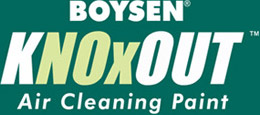February 2018
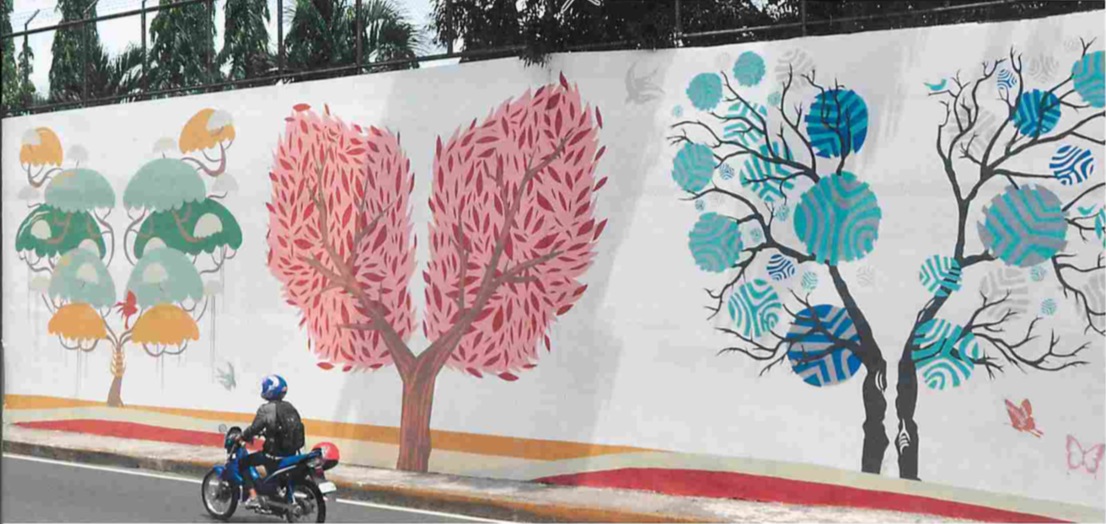
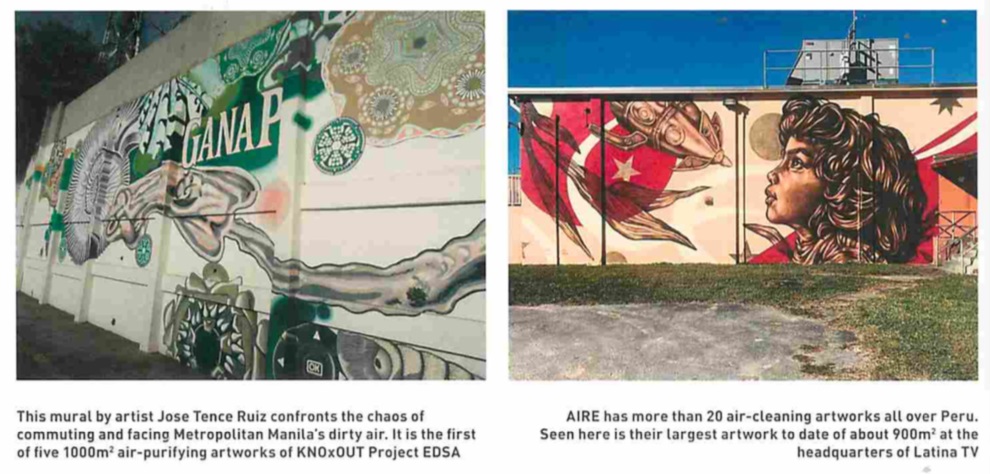
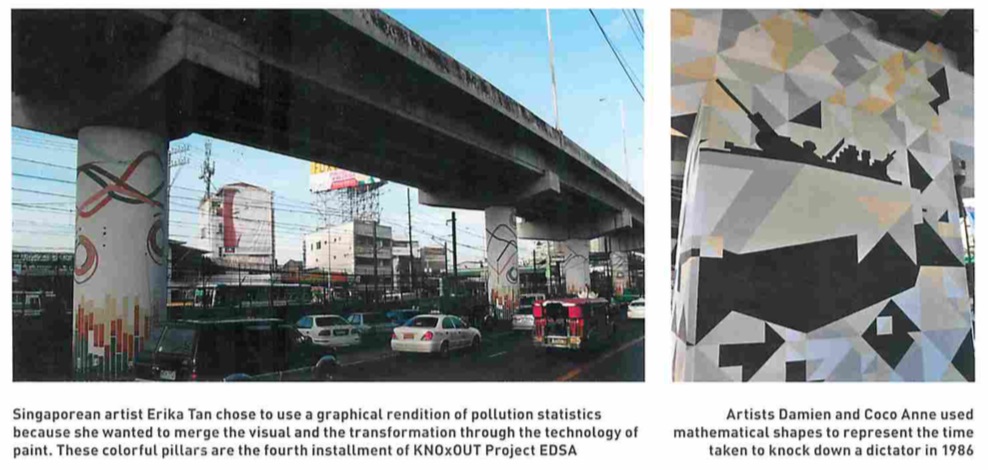
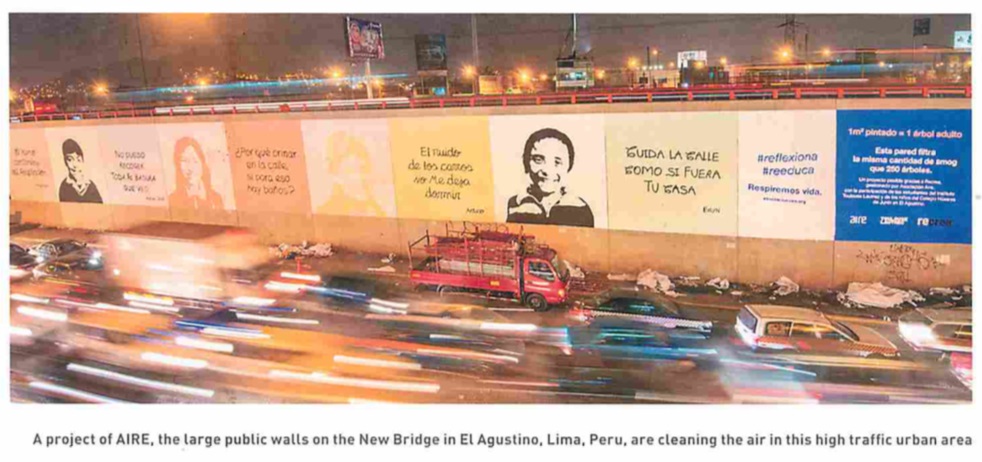
On a Stretch of walls along Manila's busiest roadway is a painting of colourful, lung shaped trees — but these painted trees are not merely a representation of trees, they are acting as if they were alive. It is not simply a case of art imitating life, it's actually paint science: just as trees act as lungs of the earth by converting carbon dioxide to oxygen through photosynthesis, these painted trees are acting as lungs of the city by converting noxious air pollutants to harmless substances through photocatalysis.
The forest of 'Tree Lungs' artwork along Metro Manila's main thoroughfare is part of the world's first large-scale public art project in which giant artworks double as air purifiers. In reference to the name Filipinos use to refer to Manila's main roadway (EDSA, for Epifanio de Ios Santos Avenue), BOYSEN® Paints, the largest paint manufacturer in the Philippines, initiated Project EDSA: Everyone Deserves Safe Air. Five artworks, each measuring about 1000m2, have been painted along the 24km stretch of EDSA, creating what is possibly the world's largest air purifier.
"With Project EDSA we're not only transforming the city's main artery into a showcase for art but we're creating massive, solar powered air purifiers along the city's most polluted roadway," says Johnson Ongking, Vice President of BOYSEN® Paints. "It's using the beauty of art and the power of science to help address the ugly problem of air pollution in our city." The secret to making artworks that also work as air purifiers is BOYSEN® KNOxOUT™, the world's first air-cleaning paint with CristaiActiv™ photocatalytic technology, which has been proven to convert air pollutants such as nitrogen oxides (NOx), sulphur oxides (SOx), and volatile organic compounds (VOCs) into harmless substances.
§ Installing Solar Powered Air Purifiers
BOYSEN®, developed KNOxOUT™ together with Cristal, the world's second largest titanium dioxide (TiO2) producer and the global leader in using ultrafine TiO2 for air quality improvement. Cristal had already been using ultrafine TiO2 as DeNOx catalysts to lower NOx emissions in power plants, as well as diesel exhaust systems for more than 30 years. While these applications significantly lowered the amount of air pollutants coming out of these sources, air in most cities is still unsafe. In fact, the World Health Organisation (WHO) estimates that 92% of the world's population lives in places where air quality levels fall below WHO standards and that air pollution leads to more than 6M premature deaths annually.
Roadside pollution from vehicle emissions poses the biggest threat to human health, because of its high concentration so close to where we live and work. Smog, an urban hazard formed by the reaction of NOx and VOCs under sunlight, can lead to health problems, particularly for children, the elderly and people with respiratory conditions, such as asthma. And while there are many efforts to reduce the level of pollutants by restricting traffic or manufacturing 'cleaner' cars, there are few practical ways available to clean pollutants that are already in the air.
A possible solution would be to install existing air purifiers around our streets but doing that on a large scale would be extremely difficult. However, our external environments are full of painted surfaces — and what KNOxOUT™ can do is transform all those surfaces into solar powered air purifiers: air purifiers that can be easily installed by painting, don't require maintenance, can't be stolen and keep working for as long as the sun comes up.
That's because of photocatalysis, a natural reaction occurring in the presence of light, water and oxygen. TiO2 , activated by the energy of the UV light ('photo'), is a catalyst that accelerates the reaction. When TiO2 is exposed to UV light, electronhole pairs are generated, facilitating reduction and oxidation reactions through the formation of adsorbed free radicals on the TiO2 surface. These radicals are highly reactive substances capable of degrading air pollutants, such as NOx, SOx, and VOCs.
Paint chemists have known about photocatalysis for a while but have always thought of it as a problem. The same mechanism that destroys air pollutants can also degrade organic resin and pigment systems in paint formulations, so paint and TiO2 companies generally formulate their products to minimise photocatalysis to maximise durability. Together with Cristal, BOYSEN® turned this paradigm on its head by designing KNOxOUT™ to maximise its photocatalytic properties to help clean the air while ensuring a long lifespan for the paint to keep the air purifier in place.
On a KNOxOUT™ paint film, light energy activates the ultrafine TiO2 , which then converts ordinary water vapour into free radicals that break down any NOx that comes into contact with the surface of the TiO2 particles. Because of its small size — 6500 of the TiO2 particles can be laid end to end across the width of a human hair — a gram of the material has a surface area of a tennis court, and this large surface area promotes a high level of contact and activity with air pollutants.
The NOx gas is converted into very diluted nitric acid, which is rapidly neutralised by the alkaline calcium carbonate particle in KNOxOUT™, producing harmless quantities of calcium nitrate, water and negligible amounts of carbon dioxide and water. Calcium nitrate is water soluble and easily removed from the film, leaving a fresh surface ready to engage with the next pollutant to come into contact with the film. Because the ultrafine TiO2 is merely a catalyst in generating free radicals, it is not consumed in the reaction, allowing KNOxOUT™ to continually clean the air as long as exposed to sufficient light.
In addition to destroying air pollutants, KNOxOUT™, which was named one of Asia's top six innovations by National Geographic in 2013, also has a powerful self-cleaning benefit. The free radicals that break down air pollutants also degrade oils that act as glue for dirt particles, creating a very hydrophilic surface that attracts water and makes surfaces easier to clean.
The air cleaning properties of KNOxOUT™ and CristalActiv have been validated in several trials globally. A subsidiary of Cristal supplied the photocatalytic coatings used for a European Union funded project called Photocatalytic Innovative Coatings Applications for De-Pollution Assessment (PICADA), which did several small scale trials that showed that the technology could reduce levels of NOx.
The world's largest air cleaning paint trial to date was done at a metro rail station along EDSA in 2009. The trial, which was monitored by the Manila Observatory, showed that the KNOxOUT™ painted on the walls of the station and surrounding area reduced nitrogen dioxide (NO2) levels by up to 20% in the area, equivalent to the NO2 emissions of more than 30,000 cars passing by the station every day. Similar levels of NO2 reductions were also seen at a trial conducted by Cristal in Camden, London.
"The Manila installation demonstrates clearly that photoactive titanium dioxide-based coatings can significantly reduce airborne NOx levels in the pollution hot spots of our cities if they are formulated and applied correctly to a high standard," said David Williams, Global Marketing Manager for the Cristal Photocatalysis business.
"Working with partners such as BOYSEN® Paints gives us confidence that the full potential of our high performance CristalActiv range wili be properly utilized."
In the process, KNOxOUT™ redefined the paradigm for green or eco-friendly paints, which have focused on having the lowest amount of VOCs possible. While having zero VOCs can, at best, mean having a neutral effect on the environment, KNOxOUT™ takes the concept of green paints further by actually improving the environment.
§ Power the People
The choice of EDSA as the canvas for the world's first air cleaning artworks was not only pragmatic, given the roadway's association with the worst of the city's traffic and pollution problems but also highly symbolic of the transformational power of KNOxOUT™, given that the EDSA Revolution of 1986 introduced the term 'people power' to the world and inspired similar non-violent resistance movements from Eastern Europe to South America.
"Every little bit counts in the fight against air pollution," says Ongking. "People have always known that air pollution wasn't good for them but they've felt hopeless in doing much about it.
"KNOxOUT™ is an empowering technology — it gives ordinary people the power to transform ordinary walls into air filters and actively fight air pollution. This EDSA project is about rekindling the spirit of 'people power' to fight the problem of air pollution. Everyone who uses a motor vehicle is part of the pollution problem, and KNOxOUT™ makes it possible for all of them to now be part of the solution. After all, we all breathe the same air and it's our common responsibility to make sure it stops being harmful to us."
"Air pollution in Metro Manila is dangerous, especially along major thoroughfares" said Dr James Simpas, Head of Urban Air Quality at the Manila Observatory, whose data showed that the average daily NO2 level along a section of EDSA was more than 4.5 times the safe limit set by the World Health Organisation (WHO) and the European Union.
On one stretch of EDSA, Singaporean artist and filmmaker Erika Tan has created a graphic rendition of pollution statistics from cities in the Philippines and elsewhere that serves as a visual reminder of how much work needs to be done in combatting air pollution. While bringing pollution levels that high down to safe levels seems like a herculean task, a study in Europe by APHEIS (Air Pollution and Health: A European Information System) found that even very small cuts in pollution can benefit health, while a Harvard University study found that people living in cities where air pollution decreased in recent decades saw their life expectancy increase by an average of five months as a result of cleaner air.
While reducing emissions at source will always be the best solution to air pollution, KNOxOUT™ enables the possibility of erasing your NOx footprint in the same way we try to mitigate our carbon footprint. While planting trees is a very effective way to offset carbon, trees are not very efficient in neutralising NOx emissions. A person who drives 20km daily on an average modern car that produces 0.15 grams of NOx per km would be producing about 3g of NOx per day, They could potentially erase that NOx footprint by painting 10m2 of a wall with KNOxOUT™ on a busy street. It would take about 10 mature trees to take out the same amount of NOx and on busy roadways like EDSA there isn't space to plant many trees — but there is a lot of space to paint.
"They say trees are the lungs of the earth and what a brilliant way to plant trees along one of the most polluted thoroughfares in Manila using BOYSEN® KNOxOUT™." said TBWA\SMP, which created the 'Tree Lungs' artwork and won a Silver trophy at the Cannes Lions International Festival of Creativity and the Planet Category for the Act Responsible Cannes Awards in 2014 for its work on Project EDSA. On another stretch of EDSA, social realist Jose Tence Ruiz created an image collection of botanical and urban debris, and thought through Chaos Theory to arrive at a symmetrical composition based on mathematician Benoit Mandelbrot's work on fractals.
§ Around the World
Halfway across the world in Lima, Peru, another artwork using KNOxOUT™ is driving behavioural change. On the walls of a school, faces of its students with road safety messages have been painted, stressing the importance of seat belts and traffic lights, as well as giving way to cyclists and ambulances. After the artwork was installed, a study found that a driver was more than twice as likely to stop to allow pedestrians to cross.
“We look to improve life quality in the city of Lima through the creation of giant artworks in the public space, painted with BOYSEN® KNOxOUT™, which is capable of filtering the air; and improve the aesthetics of cities and generate a social transformation through the creation of artistic and architectural murals with a message,” says Alejandro Gonzales and Mathieu Reumaux, Founders of AIRE in Lima, a non-government organisation that stands for Art, Innovation, Responsibility and Ecology. The World Health Organisation considered Lima the Latin American city with the worst air pollution in May 2014.
AIRE has installed more than 20 air cleaning artworks in Peru and neighbouring Colombia. Its largest artwork to date is about 900m2 and is located at the headquarters of Latina TV, supporting its campaign for taking ownership of social causes including Respect for Women, Tolerance, and a Happy Childhood. AIRE’s work was recognised with the National Environmental Award 2015 from the Ministry of Environment of Peru.
"Through the educational content of our artworks, we invite Lima's citizens to dwell upon the challenge of living together in a mega city with more than 10M inhabitants," they added. It is a philosophy completely in tune with the spirit of EDSA, which is once more the global launch pad for an international movement, this time not in the political arena but in social and environmental transformation.
In December 2017, the first air cleaning artwork using KNOxOUT™ in the USA was installed at an elementary School in Miami as part of The Raw Project campaign to support the creation of arts programmes at schools nationwide. Future air cleaning artworks are being planned in the USA and France for 2018.
On the stretch of EDSA where the 1986 Revolution happened there is now a painting by artists Asuncion and Damien Anne of bisected and quartered squares that represents the People Power event. Each square represents a minute of the 4400 minutes of - and 200 of an estimated 2M participants to — the core days of the February 1986 historical turning point. "EDSA is all about reversals," said the graphic design pair. "From authoritarian rule to democratic space. From a cowed to an emancipated middle class. From despair to a sense of possibility."
And a paint chemist may add, from breaking the convention of making paints that minimise photocatalysis to intentionally designing one that maximised it. From having sunlight trigger smog, to using sunlight to break up the components of smog. And in the process, changing the perception for the paint industry from being a source of VOC emissions to one whose products can play a large role in actively eliminating air pollutants for a cleaner and healthier environment.
- Courtesy of Asia Pacific Coatings Journal (February 2018)
